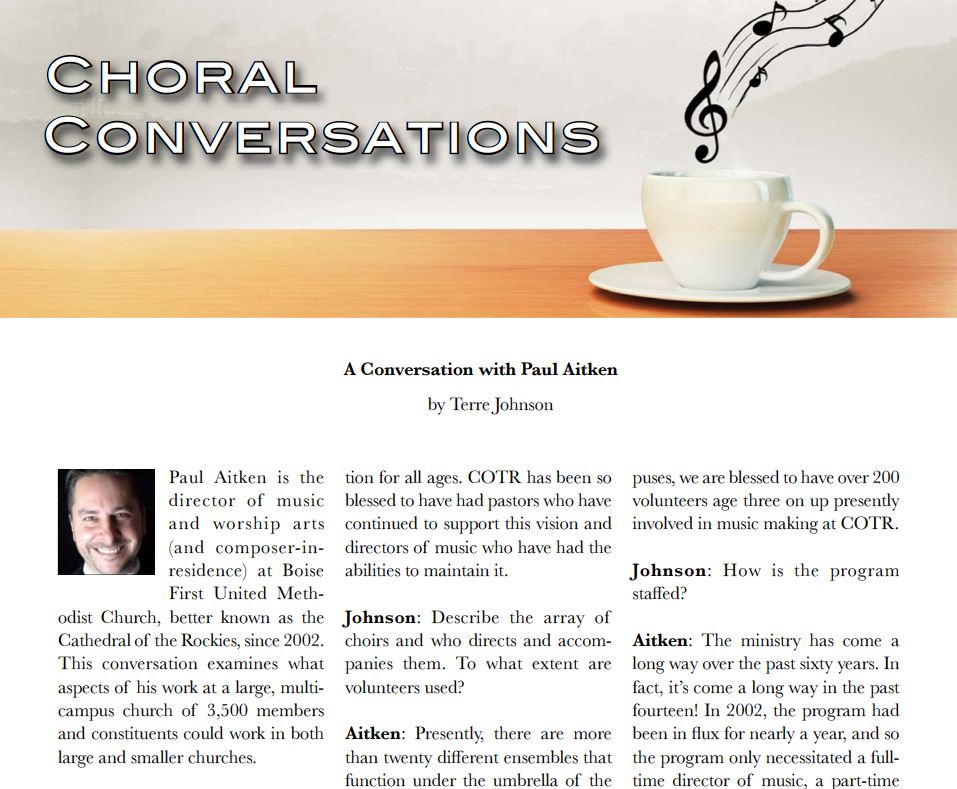
_____________________________
Choral Journal’s ongoing column called Choral Conversations” features interviews with noted choral conductors and composers. The second interview in this series took place with Paul Aitken in the June/July 2016 issue. This conversation examines what aspects of his work at a large, multi-campus church of 3,500 members and constituents could work in both large and smaller churches.
You can read the interview in its entirety online at acda.org/choraljournal. Click “Search Archives” and choose June/July 2016 from the dropdown menu.
_____________________________
Can you describe the history of the music program at the Cathedral of the Rockies?
The music program at the Cathedral of the Rockies (COTR) has a more than sixty-year tradition of graded choir programming. In 1952, Rev. Herb Richards moved to Boise as a visionary senior pastor. His vision for building a strong church in Boise was the “build it and they will come” approach. Early in his ministry, he hired two full-time directors of music (a conductor and an organist) whose responsibility was to build a graded choir program that would provide music instruction and direction for all ages. COTR has been so blessed to have had pastors who have continued to support this vision and directors of music who have had the abilities to maintain it.
Describe the array of choirs and who directs and accompanies them. To what extent are volunteers used?
Presently, there are more than twenty different ensembles that function under the umbrella of the COTR Ministry of Music & Worship Arts: a Chancel Choir comprising ninety full-time singers, the Cathedral Orchestra (20 players), the Epworth Chorale (for teens in grades 7-12), Reflections (an auditioned youth choir), five bell choirs for age four through adult, three children’s choirs for ages three through twelve, and two worship bands.
We also have a number of small ensembles that are largely self-regulated by a handful of volunteers. Further, two years ago, we took under our wing a second campus in Southeast Boise, which meant the circle was drawn wider to include a second Chancel Choir and their worship band. Between the two campuses, we are blessed to have over 200 volunteers age three on up presently involved in music making at COTR.
How is the program staff ed?
The ministry has come a long way over the past sixty years. In fact, it’s come a long way in the past fourteen! In 2002, the program had been in fl ux for nearly a year, and so the program only necessitated a fulltime director of music, a part-time organist, a part-time contemporary director, and a part-time assistant. Over the years, the program has grown to the following:
• Director of Music & Worship Arts (full time): oversees all music programming, creates worship design for two traditional services, and directs seven ensembles.
• Associate Director of Music (full time): oversees children and youth and oversees all music at the Amity campus; oversees worship design at Amity campus; directs six ensembles.
• Two Assistant Directors of Music (both part time): each position oversees one of the two contemporary services.
• Organist/Accompanist (20 hours): plays two services, accompanies four choirs, and other duties as assigned.
• Volunteer Coordinator/Assistant to the directors (an invaluable player on the music staff).
• Volunteers: singers, instrumentalists, band members (we don’t pay any of our Sunday musicians outside of the professional staff ); music librarians (team of four who work in rotation) who maintain the library and assists the director of music with weekly rehearsal preparations; fundraising team (largely for youth choir tours); parent volunteers who are involved in assisting staff with children’s choirs on Sunday mornings and Wednesday evening rehearsals; and Cathedral Concert committee (staff and volunteers).
_____________________________
Read the rest of this interview (and more!) in the June/July 2016 issue of Choral Journal.


Leave a Reply
You must be logged in to post a comment.